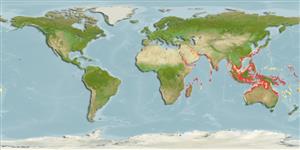>
Beloniformes (Needle fishes) >
Hemiramphidae (Halfbeaks)
Etymology: Rhynchorhamphus: Greek, rhingchos = snout + Greek,rhamphos = bill (Ref. 45335).
Eponymy: Georges Dussumier is described in the etymology as a friend of Valenciennes. [...] (Ref. 128868), visit book page.
More on author: Valenciennes.
Environment: milieu / climate zone / rango de profundidad / distribution range
Ecología
marino; agua dulce; salobre pelagic-neritic; rango de profundidad 0 - ? m. Tropical
Indo-West Pacific: the most widespread of the four species of Rhynchorhamphus, found from Persian Gulf through Arabian Sea and Bay of Bengal through the Western Central Pacific north to Taiwan and Hong Kong and east to New Guinea and northern Australia.
Length at first maturity / Tamaño / Peso / Age
Madurez: Lm 15.8, range 15 - 16.5 cm
Max length : 31.0 cm macho / no sexado; (Ref. 10943)
Espinas dorsales (total) : 0; Radios blandos dorsales (total) : 13 - 17; Espinas anales: 0; Radios blandos anales: 13 - 16; Vértebra: 54 - 59. Very strongly pronounced domed upper jaw which is the longest and most arched of the four species of Rhynchorhamphus.
Body shape (shape guide): elongated.
Found in inshore waters (Ref. 75154). Enters freshwaters (Ref 13446).
Life cycle and mating behavior
Madurez | Reproducción | Puesta | Huevos | Fecundidad | Larva
Collette, B.B. and J. Su, 1986. The halfbeaks (Pisces, Beloniformes, Hemiramphidae) of the Far East. Proc. Acad. Nat. Sci. Philadelphia 138(1):250-301. (Ref. 10943)
IUCN Red List Status (Ref. 130435: Version 2025-1)
Threat to humans
Harmless
Human uses
Pesquerías: escaso valor comercial
Herramientas
Special reports
Download XML
Fuentes de Internet
Estimates based on models
Preferred temperature (Referencia
123201): 24.9 - 29.2, mean 28.3 °C (based on 1440 cells).
Phylogenetic diversity index (Referencia
82804): PD
50 = 0.5625 [Uniqueness, from 0.5 = low to 2.0 = high].
Bayesian length-weight: a=0.00263 (0.00135 - 0.00511), b=2.95 (2.78 - 3.12), in cm total length, based on LWR estimates for this species & (Sub)family-body (Ref.
93245).
Nivel trófico (Referencia
69278): 3.1 ±0.2 se; based on size and trophs of closest relatives
Generation time: 0.8 ( na - na) years. Estimated as median ln(3)/K based on 1
growth studies.
Resiliencia (Referencia
120179): Alto, población duplicada en un tiempo mínimo inferior a 15 meses (K>1).
Fishing Vulnerability (Ref.
59153): Low vulnerability (16 of 100).
🛈
